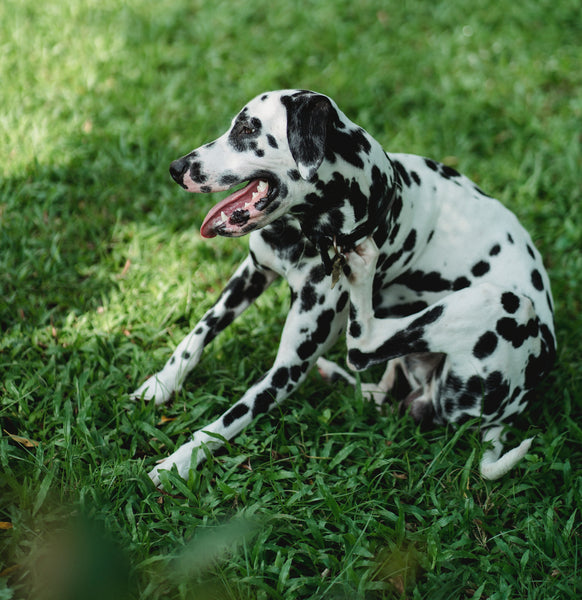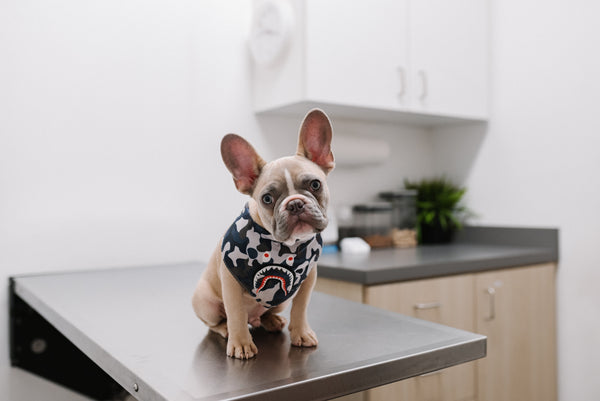Your dog has been a little restless lately, scratching and licking themselves more than usual. When you look over your pet, you notice something strange about his skin - it looks inflamed and irritated in some areas.
Although you love your dog, you don't know the first thing about dog skin conditions, so you take him to the vet immediately. Your vet confirms your dog has a skin condition, but it's hard to identify which one without further testing. As the vet runs some tests, they explain that dog skin problems and bacterial infections can come from a myriad of reasons, such as allergies or yeast infections.
However, without knowing much about skin conditions in dogs, it's hard to prevent them or know what to do when they show up.
But don't worry. We have you covered.
In this article, we'll be discussing the 10 most common skin conditions in dogs that you should be aware of. By knowing about these conditions, you can help your pup feel better faster by recognizing symptoms and seeking medical assistance when needed.
What Can Happen if a Skin Condition Gets Left Untreated?
If left untreated, skin conditions can become severely infected or cause more serious illnesses. Dogs may experience further irritation and inflammation, hair loss, infections, and even permanent scarring.
Aside from experiencing pain, this discomfort could affect their quality of life. Try to recognize the signs and symptoms as soon as possible so you can discuss treatment options with your vet.

How Can I Notice if My Dog Has a Skin Condition?
The signs of skin conditions are quite diverse, but there are common indicators that you should be on the lookout for.
These might include:
- itchy, red skin;
- dry, flaky patches;
- bumps or scabs;
- hair loss;
- excessive licking or scratching; and
- a foul odor.
Most dogs will also exhibit signs of discomfort when they have a skin condition, such as acting restless or withdrawn from their normal activities.
Now that you know the symptoms to look out for, let's take a look at some of the most common skin conditions in dogs:
Allergies
Allergies are the most common cause of skin conditions in dogs. Allergens such as dust, pollen, and certain ingredients in food can trigger an allergic reaction that results in red, itchy skin, and inflammation. Allergies may also lead to secondary skin infections caused by bacteria or yeast.
The best way to prevent allergies in dogs is to identify and avoid the allergens that are causing the reaction.
Where do allergies in dogs come from?
Allergens can be found in many places including the environment, food, and even fleas.
Some of the most common environmental allergens include dust mites and grasses. Food allergies usually stem from proteins that are found in certain foods like beef, wheat or fish. Flea saliva is also known to cause an allergic reaction in some dogs.
How are Allergies Diagnosed?
Your vet will likely conduct a physical exam and ask questions about your dog's lifestyle and diet to help narrow down the possible allergens. Allergy tests also may be conducted to measure how your pup reacts to certain substances.
If there's reason to believe the allergy comes from your dog's diet, your vet may also suggest an elimination diet, a process where specific ingredients are removed from their meals for several weeks until symptoms subside.
Helpful options
Once an allergen is identified, your vet can recommend medication or other treatments, such as environmental modifications (e.g., washing bedding regularly) that can help manage the condition.
Helping reduce allergies in dogs can also mean making changes to their diet, adding quality-grade supplements, as well as using any medications a vet prescribed to reduce inflammation and itching. In terms of skin health, regularly grooming your dog can help reduce skin irritation caused by allergies.

Mange
Mange is a skin condition caused by mites that burrow into the skin, often leading to severe itching and inflammation. There are two types of mange: sarcoptic mange, which affects the whole body, and demodectic mange, which is localized to certain parts of the body.
Sarcoptic mange
Sarcoptic mange is caused by the Sarcoptes scabiei mite, which is highly contagious and can easily spread between animals. Dogs can contract sarcoptic mange from other dogs or even wild animals like foxes and coyotes.
How can I tell if a dog has sarcoptic mange?
Dogs with sarcoptic mange will often have skin lesions or hair loss. They may exhibit intense itching, which can lead to red, scaly skin. Severe cases may also cause visible mites on the skin.
If you believe your dog was in contact with another dog who has sarcoptic mange, bring your pet to the vet for an examination and keep them away from other animals.
Demodectic mange
Demodectic mange is caused by the Demodex mite, which lives in hair follicles and can cause hair loss and skin irritation. This type of mange is not contagious and usually only affects young dogs with weakened immune systems or older dogs who have an underlying medical condition.
How can I tell the difference between demodectic mange and sarcoptic mange?
Demodectic mange usually appears as hairless patches on the face, neck, or legs, whereas sarcoptic mange is more widespread. Regardless, bring your pet to the vet for a diagnosis since both types of mange have similar symptoms.
Can humans contract mange from dogs?
Animal mites can get under the skin of people who have close contact with an animal with "mange" and cause temporary itching and irritation. Animal mites, however, cannot reproduce on people and will die naturally within a few days.
Can cats and other animals get mange?
Yes, although not as common as in dogs, cats and other animals can get mange. Sarcoptic mange is highly contagious and can spread easily between animals.
If you have other pets at home, keep them away from a dog with mange until the condition is treated and cleared up by a veterinarian. This will help prevent the spread of these parasites to other animals in your household.

What tests are run to diagnose mange?
Your veterinarian will likely start by performing a physical examination and testing some samples of the skin lesions under a microscope.
If sarcoptic mange is suspected, your vet may also perform an intradermal test to confirm the diagnosis. This involves injecting small amounts of antigen into the skin of the dog, then measuring for any allergic reactions at later examinations.
Helpful options
The best way to treat mange is to bring your dog to the vet for an examination and testing. If diagnosed with either type of mange, your veterinarian can recommend treatments, such as topical medications or oral antibiotics, to help clear up the infection.
Keep in mind that it may take several weeks before you see results from these treatments. In the meantime, be sure to keep your dog away from other animals until their condition improves.
Fortunately, there are also a lot of at-home remedies that you can also use to help your dog with mange. These are inexpensive and generally require little prep.
Dry Skin/Dandruff
Dry skin or dandruff is also a common skin issue in dogs, especially during the colder months. This condition may be caused by a lack of essential fatty acids or environmental factors, such as extreme temperatures, dry air, or poor humidity.
How can I tell if my dog has dry skin?
Dry skin usually presents itself as patches of red or flaky skin and excessive shedding (especially during the summer). Your dog may also have an itchy feeling that’s difficult to manage without proper treatment. If left untreated, your pet might experience permanent hair loss due to excessive scratching and licking.
What are some causes of dry skin in dogs?
The most common cause of dry skin in dogs is a lack of essential fatty acids. These are found in foods that are rich in Omega-3 and Omega-6, such as salmon, eggs, flaxseed, and sunflower oil.
Environmental factors such as extreme temperatures or poor humidity can also cause dry skin in dogs. Note that in some cases, the underlying cause may be an endocrine disorder, such as hypothyroidism or Cushing’s disease, which should be diagnosed and treated by your veterinarian.
Helpful options
If your dog has been diagnosed with dry skin, helpful options may include adding more fatty acids to your dog’s diet and using a medicated shampoo, topical cream, or skin ointment to soothe the affected area.
Your veterinarian may also recommend using supplements to improve your dog’s overall health and reduce the risk of dry skin.
Keep in mind that it can take several weeks for these treatments to work, so be sure to follow up with your vet regularly and keep an eye on your pet's progress.

Hot Spots
Hot spots (also called acute moist dermatitis) are inflamed or infected areas of skin that appear as red, raised patches. These spots are the result of an underlying infection or allergy and can be very itchy and uncomfortable.
How can I tell if my dog has a hot spot?
Hot spots usually appear as red, wet patches on your dog’s skin that may be accompanied by hair loss. Your pet may also display behaviors such as licking, scratching, or biting at the affected area. If left untreated, these spots can become infected and cause further pain and discomfort for your pet.
What causes hot spots in dogs?
Hot spots in dogs are typically caused by an underlying infection or allergy. They may also be caused by excessive grooming, which causes trauma to healthy skin, and opens up new pathways for bacteria to enter.
Helpful options
If your dog is diagnosed with hot spots, the most prudent thing to do is get them treated right away. Helpful options include:
- antibiotics to clear up any infections;
- anti-inflammatory medications to reduce swelling;
- specific shampoos to cleanse the wound; and
- topical ointments for soothing relief.
It’s also important to address the underlying cause of the hot spots, whether it be an infection or allergy. This may involve making dietary changes or taking your pet to a specialist for further investigation.
Yeast Infections
Yeast infections are skin problems caused by an overgrowth of yeast on the skin, which can cause redness, itchiness, and a strong odor. These infections are typically caused by allergies or hormone imbalances and can be difficult to treat without proper medical attention.
How can I tell if my dog has a yeast infection?
Yeast infections usually appear as dry or flaky patches of skin that may have a reddish hue. Your pet may also experience intense itching and scratching, which can lead to further irritation. You may also notice your pet licking or biting at affected areas more often than usual.
How can I prevent my dog from getting yeast infections?
There are a lot of ways to mitigate the chances of a yeast infection in dogs, such as:
- Keep your pet’s skin and coat clean and healthy. With regular grooming, you can help remove any dead hair or dandruff that may be harboring yeast spores
- Watch out for any signs of allergies or hormonal imbalances. These factors can lead to an overgrowth of yeast on the skin.
- Ensure your pet has access to fresh water at all times. Water can help flush out toxins that may cause infection.
- Provide your dog with essential fatty acids such as fish oil. This will help maintain their skin health.
- Keep your pet’s environment clean and free of allergens or irritants. These can trigger an overgrowth of yeast.
How is yeast detected in dogs?
Yeast infections are typically diagnosed through a process called cytology. This involves taking a swab of the affected area and examining it under a microscope. Additionally, skin scrapings or blood tests may be used to confirm the presence of yeast.
Helpful options
Your veterinarian may recommend medications such as antifungal shampoos, creams, or oral tablets to help clear up the infection. In some cases, your vet may also suggest changes to your pet’s diet and environment to reduce the risk of recurrence.
It can take several weeks for yeast infections to clear up completely, so be sure to follow all instructions provided by your veterinarian. Additionally, regularly groom and inspect your dog’s skin and coat to catch any signs of the infection coming back.
Ringworm
Despite the name, ringworm isn't actually caused by worms.
Ringworm is an infection caused by a fungus which can affect both humans and animals. Ringworm can present itself in a variety of ways but is usually visible as red, scaly patches that often appear ring-shaped. The skin may also be raised and itchy. In some cases, the patches may have black dots or pus-filled bumps in the center.

How can I tell if my dog has ringworm?
Your pet may also be itching excessively at these areas or licking them more than usual. If left untreated, this condition can spread to other parts of your pet’s body and cause more severe symptoms, such as fever, lethargy, and generalized itchiness.
How is ringworm transmitted?
Ringworm infections can occur when your pet comes into contact with an infected person or animal. The fungus that causes ringworm can also be found in soil and on contaminated objects, such as bedding, grooming tools, and toys.
With that being said, take precautions when handling these items.
Can humans get ringworms from dogs?
Ringworms can be transmitted to humans by touching an infected dog. However, if your skin is unbroken you will not be able to contract ringworm. On the other hand, if you have scratches, grazes, or wounds, or suffer from eczema, you may become infected.
How can my vet diagnose ringworms?
Your vet can diagnose ringworms in your dog by performing a physical exam of the affected area and taking samples from the skin for further testing.
Your vet may use a Wood's lamp, which is a special light designed to make fungal infections easier to see. They may also take a culture sample or scrape away some infected material and check it under the microscope to confirm the diagnosis.
Helpful options
Your veterinarian may recommend the use of antifungal shampoos, creams, or oral medications to treat your pet’s ringworm infection. In some cases, they may also suggest changes to your pet’s diet to boost their immune system and improve their overall health.
Additionally, it’s important to thoroughly clean all bedding, toys, and other items that your pet has come into contact with to prevent further spread of the fungus.
Vitiligo
In the same way as humans–but less common, dogs and cats can develop vitiligo. Vitiligo causes the skin to lose its natural pigment and create white patches of hair.
No matter how strange your dog or cat looks with patches of white fur or skin, there is no need to worry. The condition is painless and won't cause any problems for your pet.

What causes vitiligo in dogs?
The pigment-producing cells known as melanocytes are destroyed in dogs with vitiligo, this is what leads to a loss of pigmentation on the skin.
Several factors can lead to this condition, including genetic predisposition, immune system dysfunction, hormonal imbalances, and environmental toxins or prolonged sun exposure that destroy melanocyte cells.
In some rare cases, vitiligo can also be triggered by physical trauma or an allergic reaction.
Helpful options
Managing vitiligo may include topical medications to stimulate repigmentation and camouflage creams to conceal any patches that remain pale. In some cases, ultraviolet light therapy may be used to restore coloration in affected areas.
Can I leave vitiligo untreated?
Vitiligo is generally not considered a serious condition, and many owners choose to leave it untreated. However, dog owners should consult their veterinarian if they notice any changes in their pet’s skin as these can be indicative of other more serious conditions.
Additionally, some owners may opt to treat the condition for cosmetic reasons. It is important to note that prolonged sun exposure can cause further damage to affected areas, so dogs with vitiligo should be protected from overexposure with sunscreen or protective clothing. Proper care and regular monitoring of your pet's skin are essential for maintaining good overall health.
Seborrhea
Dogs with seborrhea suffer from keratin problems in their skin. The protein keratin is what gives skin and hair their shape.
In canine seborrhea, too much or too little keratin is produced. As a result of seborrhea, dogs' coats become dry, dull, and greasy.
Veterinary practitioners describe seborrhea in dogs as either primary or secondary.
Primary seborrhea
A dog with primary seborrhea always produces abnormal keratin as a result of a genetic disease.
Since American Cocker Spaniels, West Highland White Terriers, English Springer Spaniels, and Basset Hounds all have short coats with thick undercoat fur, they tend to be more prone to developing this type of skin disorder.
However, it’s important to note that any dog can suffer from it.
Secondary seborrhea
In secondary seborrhea, your dog's skin produces abnormal keratin due to an underlying issue.
Secondary seborrhea can be caused by the following health issues:
- Unbalanced hormones
- Having allergies
- Vitamin deficiency
- Lupus and other immune-mediated diseases
- Skin lymphoma
What are the symptoms of seborrhea?
The most common symptom of seborrhea is greasy dure and scaly skin underneath it. Your dog may also have excessive dandruff, hair loss, itching, and redness.
The folds of skin between toes, under armpits, on the belly, perineum (the area under a dog's tail), and at the bottom of the neck are typically worse affected by seborrhea, as these areas are prone to excessive moisture from sweat and urine, which can lead to skin irritation.
With that being said, dogs with lots of skin folds like Basset Hounds, usually experience more skin irritation when it comes to seborrhea.

What can I do to help manage seborrhea?
Managing seborrhea usually involves medicated shampoos or topical creams designed to help reduce oil production. In more severe cases, oral medications or dietary changes may also be necessary to get your pet’s symptoms under control.
Additionally, it’s important to keep the affected area clean and dry to prevent any secondary bacterial infections from developing.
Intertrigo
Intertrigo is a type of bacterial infection that occurs in skin folds when the area becomes warm and moist. When mixed with friction, it can be extremely uncomfortable for a dog with a “screw tail” or several skin folds such as bulldogs.
Skin folds in dogs are a perfect, moist place for yeast and bacteria to collect. This collected bacteria and yeast over time is ultimately the reason for Intertrigo.
What are the symptoms my dog has in intertrigo?
The main symptom of intertrigo is red, itchy skin. This can be accompanied by odor, discharge and swelling if the infection is severe. Your dog may also display symptoms such as licking and biting at the affected area, or excessive scratching which can lead to sores.
What breeds are the most susceptible to intertrigo?
Breeds that are most susceptible to intertrigo are those with heavy wrinkles or a lot of skin folds, such as Chinese Shar-Pei, Pugs, Bulldogs and English Mastiffs. Other breeds that may be more prone to it include Cocker Spaniels and Basset Hounds because
These dogs are more susceptible to intertrigo because as previously mentioned the warm, moist environment that is created within their deeper skin folds provides the perfect place for bacteria and yeast to grow and thrive.
Additionally, due to their thicker skin, these breeds typically have a harder time regulating their body temperature which can lead to excessive sweating. This further adds to the build-up of moisture which increases the risk of developing this type of infection.
How can I help manage intertrigo?
Fortunately, there are several steps that pet owners can take to help intertrigo in their dogs.
Firstly, it’s important to keep the skin clean and dry by cleaning the affected area regularly with soap and water. Additionally, trimming the fur around the affected area can help eliminate any extra warmth or moisture that may be caused by excessive hair growth. Finally, wiping down skin folds with a damp cloth after baths and exercise can also help reduce the risk of developing this infection.
By choosing a specially formulated shampoo with chlorhexidine, not only can you reduce inflammation, but you can kill any unnecessary bacteria on your dog.
It’s also essential to make sure your pup is getting plenty of exercise as well as eating a nutritious diet to maintain good overall health. This will ensure their immune system is functioning optimally so it can better fight off any potential infections.
If you notice any signs of intertrigo such as redness, swelling, or a foul odor in your dog’s skin folds, schedule an appointment with your veterinarian right away. With the proper management and preventive measures, most cases of dog skin conditions can be effectively managed.
Helpful options
Managing intertrigo typically involves the use of medicated shampoos and ointments to help reduce inflammation, dry out the affected area, and keep it clean. Your vet may also prescribe oral antibiotics or anti-inflammatories for more severe cases.
In addition to medical treatments, your vet may also recommend dietary changes such as adding more omega-3 fatty acids to your pup’s diet which can help reduce inflammation and boost their overall immune system. If necessary, you should also make sure that your pet is getting plenty of exercise to help maintain a healthy weight and avoid putting too much strain on their skin folds.

Autoimmune Diseases
Autoimmune diseases are another type of dog skin condition that can cause a variety of symptoms including hair loss, itching, and redness.
These conditions occur when the immune system mistakenly attacks healthy cells in the body rather than foreign invaders such external parasites such as bacteria or viruses. Autoimmune disorders can range from mild to severe, so it’s important to educate yourself and work with your vet to determine the best course of action.
What types of skin autoimmune diseases can dogs have?
Common autoimmune diseases in dogs include pemphigus, lupus, and Bullous pemphigoid. Each of these conditions has its own set of symptoms that can range from mild to severe.
Pemphigus
Dogs can suffer from pemphigus, a relatively uncommon autoimmune skin disease. Each form of the disease (pemphigus foliaceus, pemphigus erythematosus, pemphigus vegetans, and pemphigus vulgaris) results in a painful skin separation due to antibodies attacking the components of the skin.
Pemphigus has three possible causes: endogenous (internal), exogenous (external), and idiopathic (undetermined).
What does pemphigus look like in dogs?
Dogs with pemphigus typically develop red, raised spots on their skin that may or may not be painful. It is common for these to have crusts or scabs, and they can range in size from very small to very large.
You may also notice that your dog is losing hair or developing lesions around their face, ears, feet, and/or tail.
Those with pemphigus vulgaris may develop vesicles, which are fluid-filled blisters. These vesicles rupture often, leaving painful ulcers.
It is common to see lesions around the lips and eyes, but they can spread to other areas of the body over time
How is pemphigus managed in dogs?
Managing pemphigus usually involves immune-suppressing medications, such as corticosteroids to help reduce inflammation and decrease symptoms. In more severe cases, additional medications such as antibiotics, antifungal ointments and topical steroids may also be prescribed.
In addition to medication, keep your dog’s skin clean by bathing them regularly with a mild shampoo and avoiding anything that could irritate irritated skin or inflame the area, such as excessive grooming, scratching, or licking. Providing a nutritious diet is also essential to maintain their overall health.
Lupus
Lupus is an autoimmune disorder that can affect the skin, joints, and other organs in dogs. It is caused when the body's immune system attacks or begins to attack its own cells and body tissues and can range from mild to severe.
The most common signs of lupus in dogs are lesions on the skin or eyes, as well as alopecia (hair loss) or scaling of the skin. In some cases, you may also notice that your pup is feeling lethargic, has a decreased appetite or has joint pain.
How is lupus managed in dogs?
Managing lupus typically involves the use of immunosuppressive drugs, such as corticosteroids as well as Vitamin E supplements to help reduce inflammation and prevent further damage to the skin. In more severe cases, additional medications such as antibiotics or antifungal medication may also be prescribed.
Make sure that your pup is eating a nutritious diet to maintain its overall health. Lastly, avoiding excessive grooming or scratching of the affected area can help minimize the risk of aggravating any existing lesions or inflammation.

Bullous pemphigoid
Bullous pemphigoid is an autoimmune skin disorder that affects the skin and mucous membranes in dogs. It is caused when antibodies mistakenly attack healthy proteins found in the body, leading to severe blistering on the skin which can become painful and inflamed.
The most common signs of bullous pemphigoid in dogs are red or purple raised lesions that may be filled with fluid. These typically form on the head, feet, and groin area but can also spread to other parts of the body over time.
In some cases, you may also notice that your pup is feeling lethargic or has a decreased appetite, which could be caused by the inflammation of this condition.
How is bullous pemphigoid treated in dogs?
Managing bullous pemphigoid usually involves the use of immunosuppressive drugs such as corticosteroids as well as topical ointments and shampoos to help reduce inflammation. In more severe cases, additional medications such as antibiotics or antifungal medication may also be prescribed.
In addition to medical treatments, make sure that your pup is getting plenty of exercise and eating a nutritious diet to maintain their overall health. Finally, avoiding excessive grooming or scratching of the affected area can help minimize the risk of aggravating any existing lesions or inflammation.
Helpful options
Helpful options for autoimmune conditions vary depending on the type and severity of the condition. Generally, as mentioned medications are prescribed to help reduce inflammation and suppress the immune system.
However, in more severe cases, surgery may be required to remove damaged tissue or organs.
Alopecia (hair loss)
Alopecia is a type of dog skin condition in which the dog loses some or all of its fur. It can be caused by several factors, including hormonal imbalance, infection, allergies, environmental changes, parasites, and immune-mediated diseases.
While alopecia can affect any breed of dog at any age, it is more common in middle-aged to older dogs. The reason behind this is that as the body ages, it is more susceptible to conditions such as alopecia.
Alopecia does not usually cause any pain or discomfort in dogs. However, some affected dogs may experience itchiness and skin irritation due to the underlying underlying skin condition.
What are the symptoms of alopecia in dogs?
Symptoms of alopecia in dogs include patches of bare skin or fur loss and bald patches that may be symmetrical or irregular in shape. Sometimes a dog may have just one patch of baldness, while other times, there can be multiple areas affected on the body.
In addition, a dog with alopecia may also have redness and irritation at the site of hair loss.
How can I help manage alopecia in dogs?
The most common treatment for alopecia in dogs is to identify and address the underlying cause. Depending on the cause, this could include treating an infection or parasites or changing your dog’s diet. Additionally, your vet may prescribe medications such as antibiotics, corticosteroids, or other immunosuppressants to reduce inflammation and help with hair regrowth.
Some cases of alopecia can be permanent if the condition is caused by a serious underlying illness or medical issue that cannot be treated. In these cases, it may be necessary to provide supportive care such as regular grooming and skin care regimen, supplemental fatty acids, or other treatments recommended by your vet to keep your pet comfortable and healthy.

What happens if I leave alopecia untreated?
If left untreated, alopecia can lead to severe skin irritation, infection, and even skin cancer in some cases. This is because the lack of fur or hair provides less protection against UV rays and other environmental factors that can cause skin damage.
Additionally, alopecia can be a symptom of an underlying medical issue that, if left untreated, could result in further complications for your pet.
Therefore, seek veterinary care for your dog if you notice any signs of alopecia.
Can I Give My Dog a Skin Condition?
No, dogs cannot directly catch bacterial skin infections or conditions from humans. However, you can inadvertently transfer parasites or bacteria to your pup through contact which could cause a serious skin infection or condition.
Always practice good hygiene and avoid coming into direct contact with any potentially infectious materials. Taking steps to maintain your pup's overall health, such as providing them with a nutritious diet and regular exercise, will help reduce their risk of developing certain skin conditions.
Why is it Important to Understand Common Skin Conditions in Dogs?
By understanding the most common dog skin conditions, pet owners are better equipped to identify and treat their furry friends when necessary. Early detection and prompt medical attention can ensure that these diseases don't progress further and cause long-term damage to your pup's overall health. This can help you get your pup the treatment they need quickly, which could ultimately save their life.
If you think your pup is exhibiting any signs or symptoms of a skin autoimmune disorder, it’s best to contact your vet right away so they can provide an accurate diagnosis and create an effective treatment plan.














